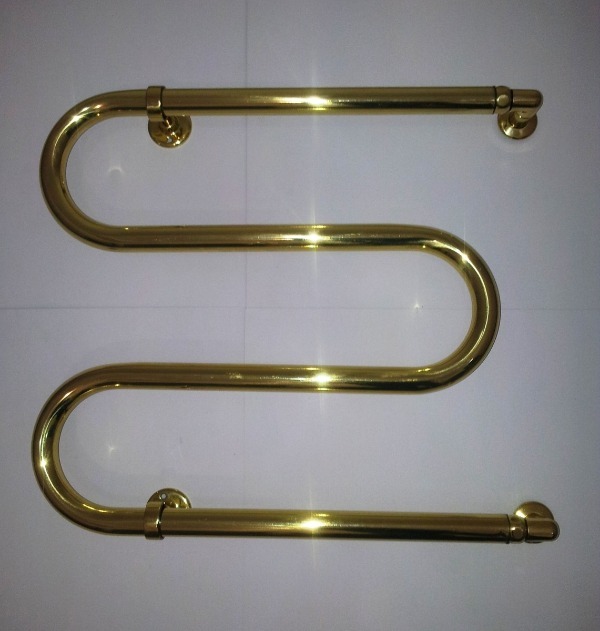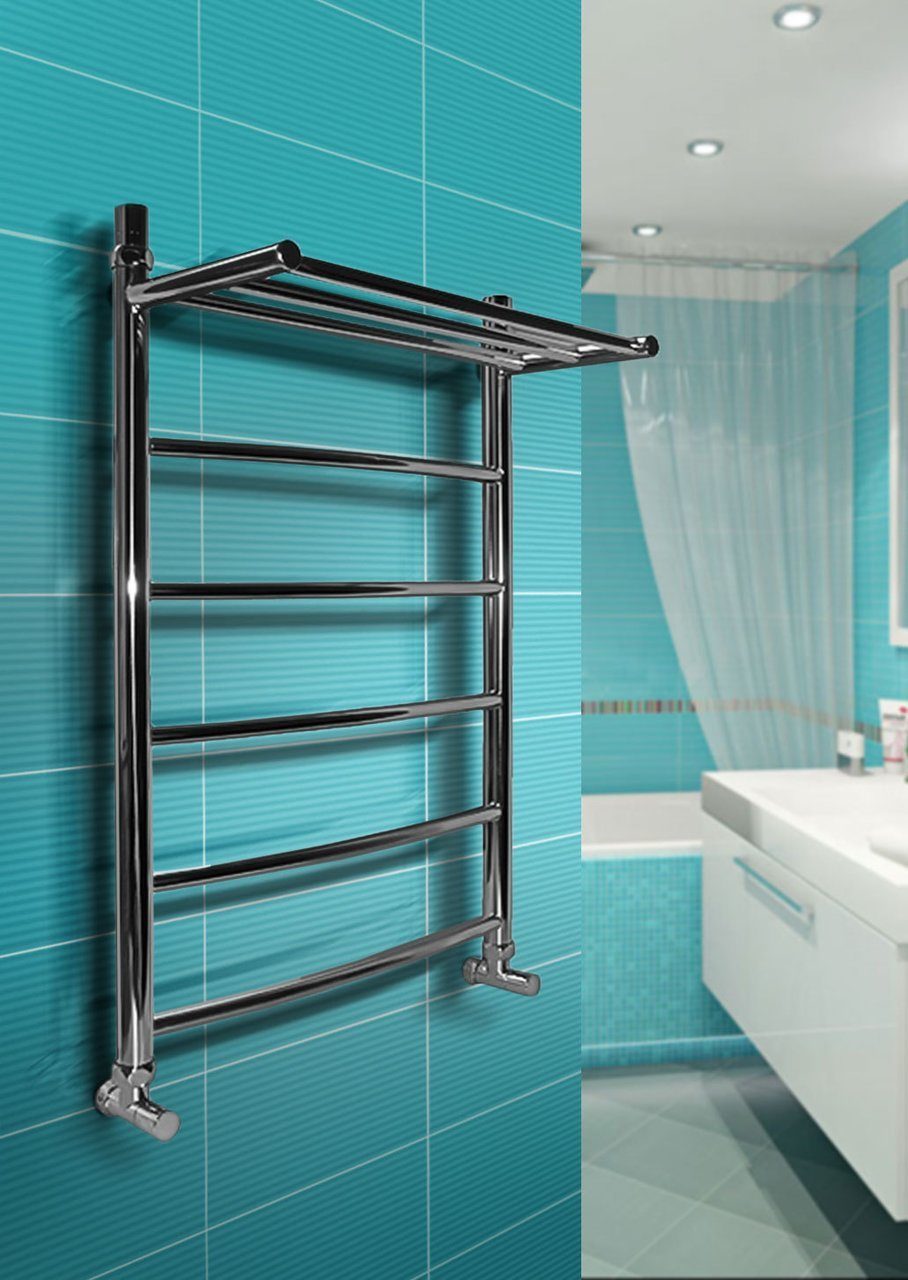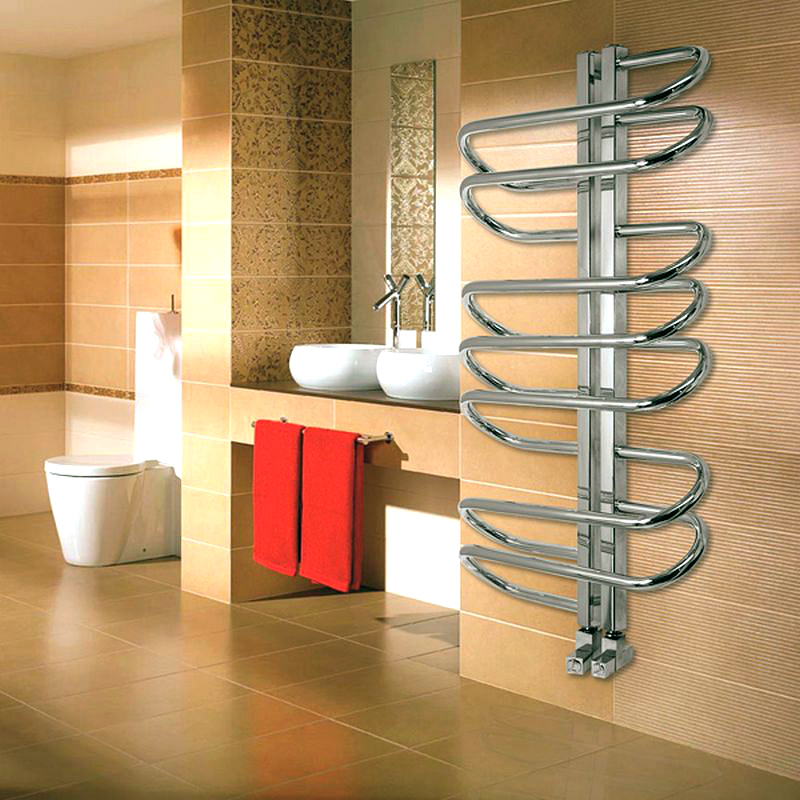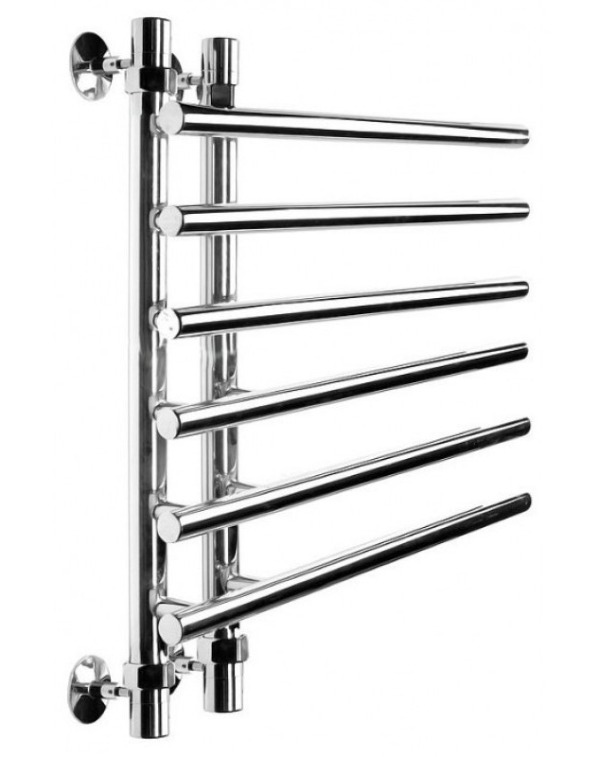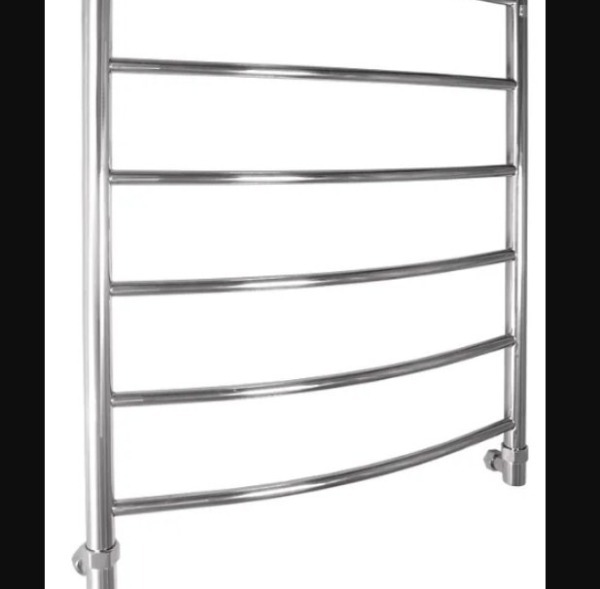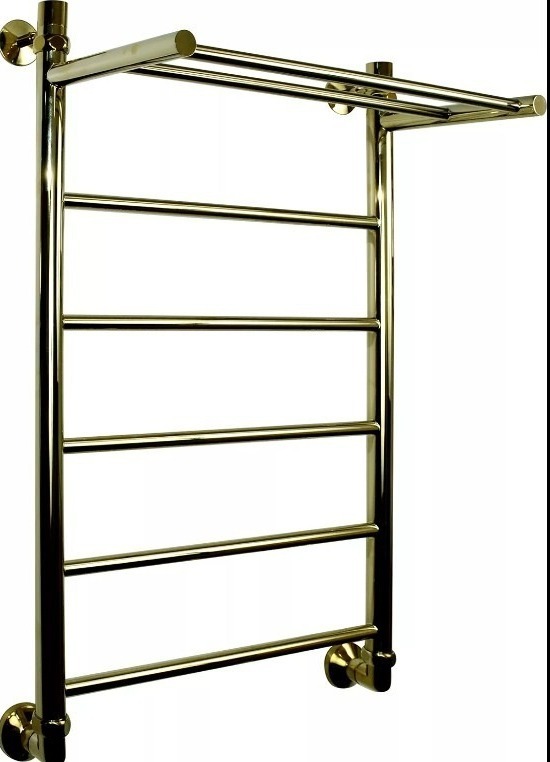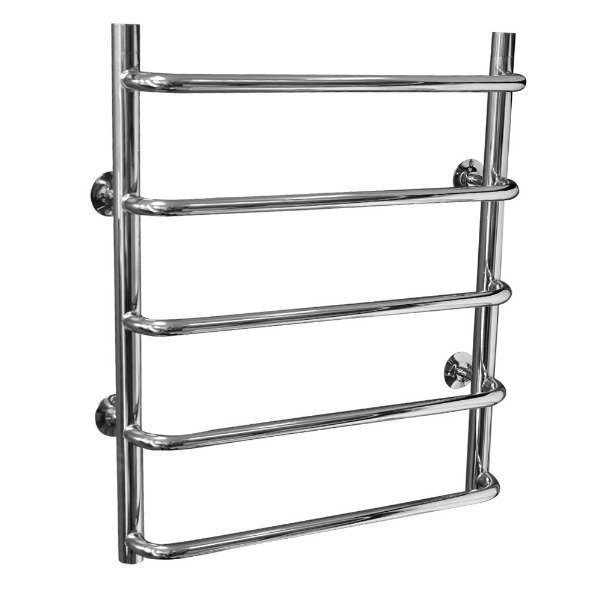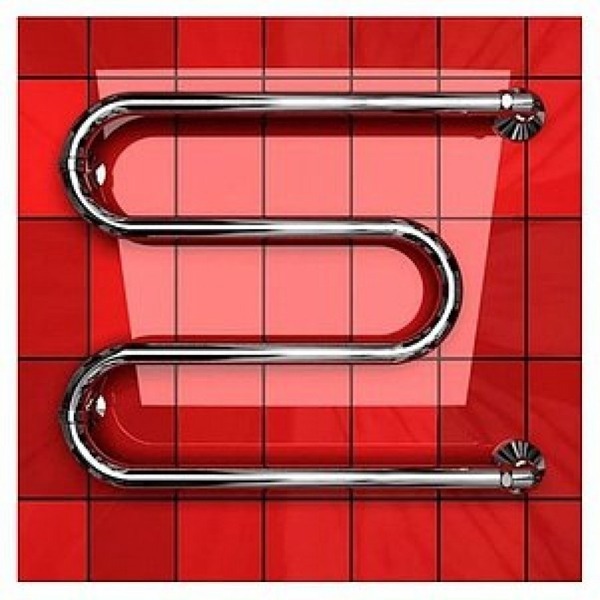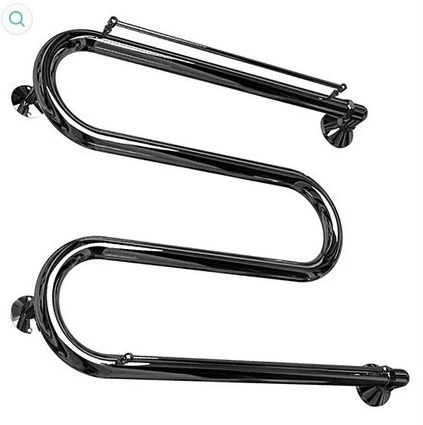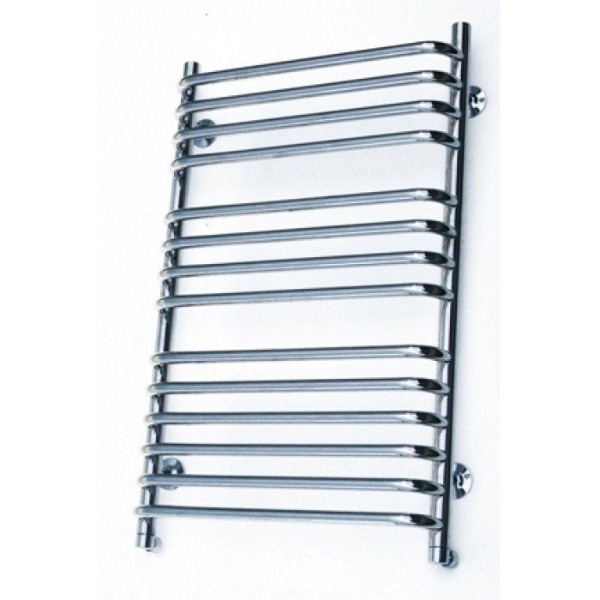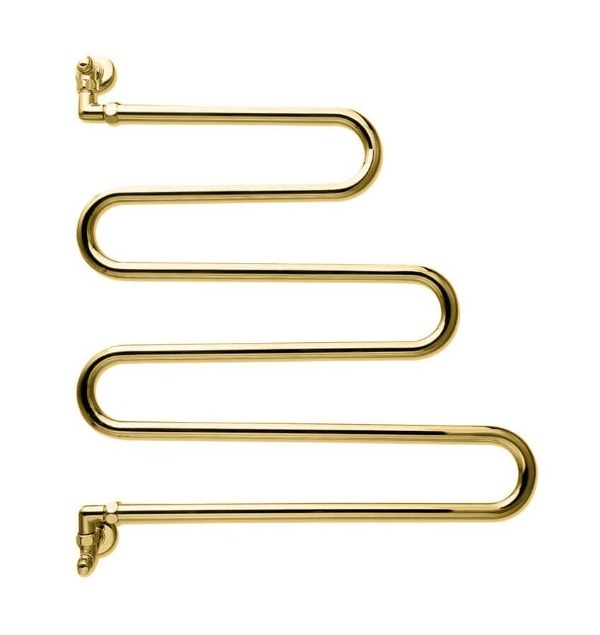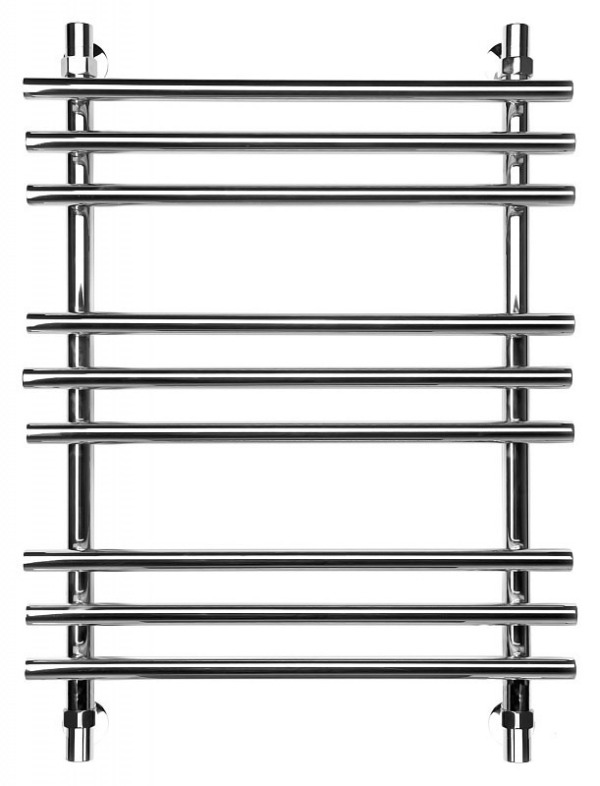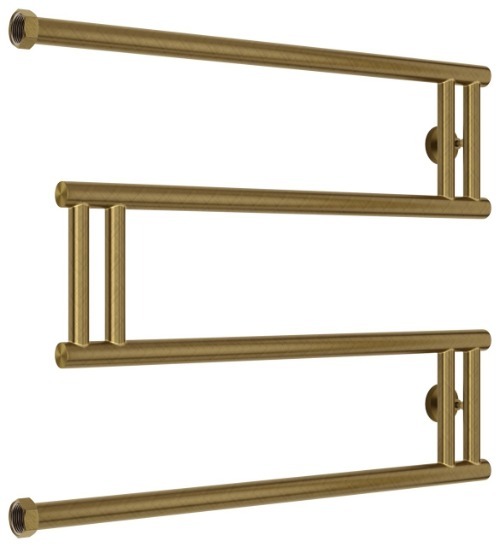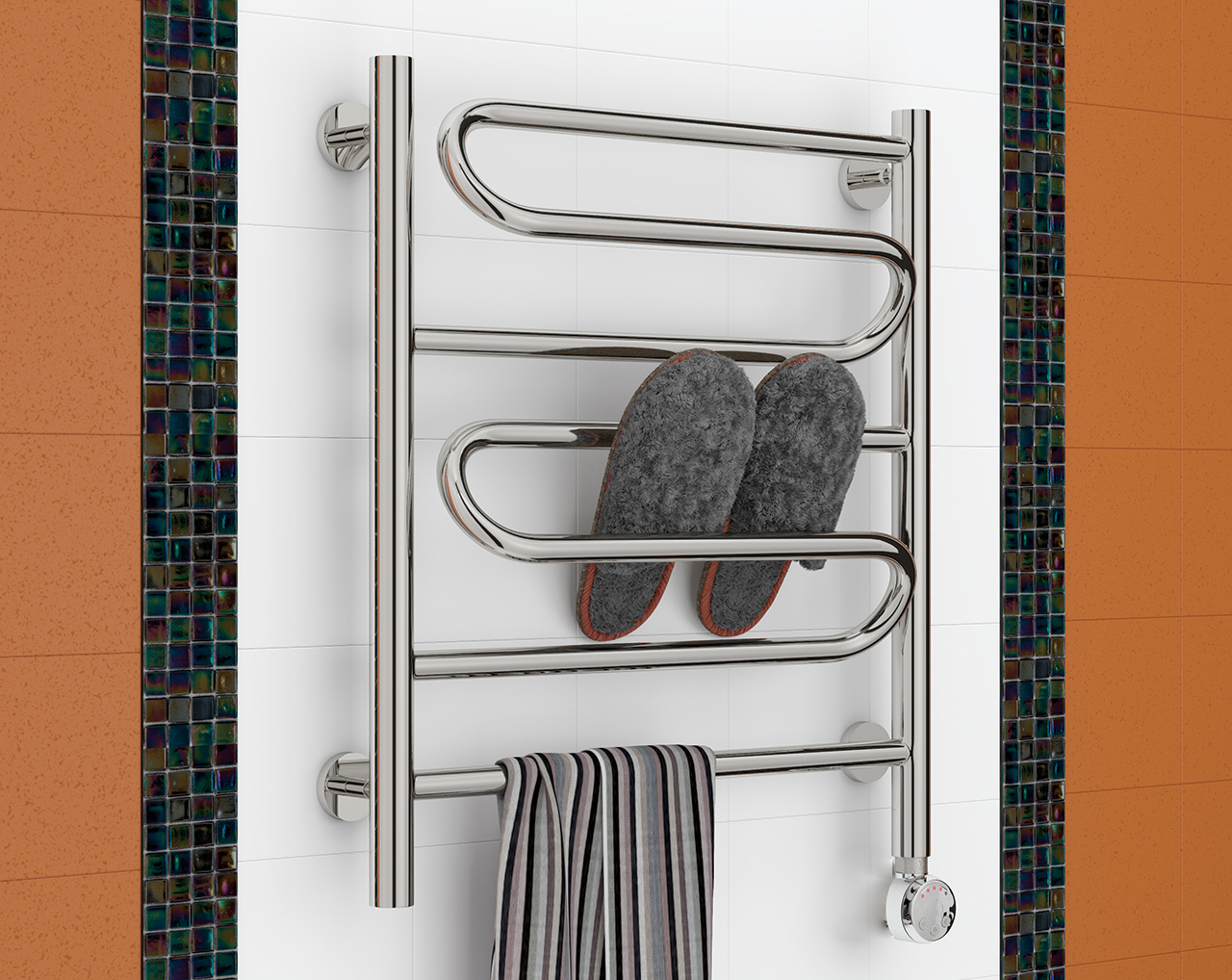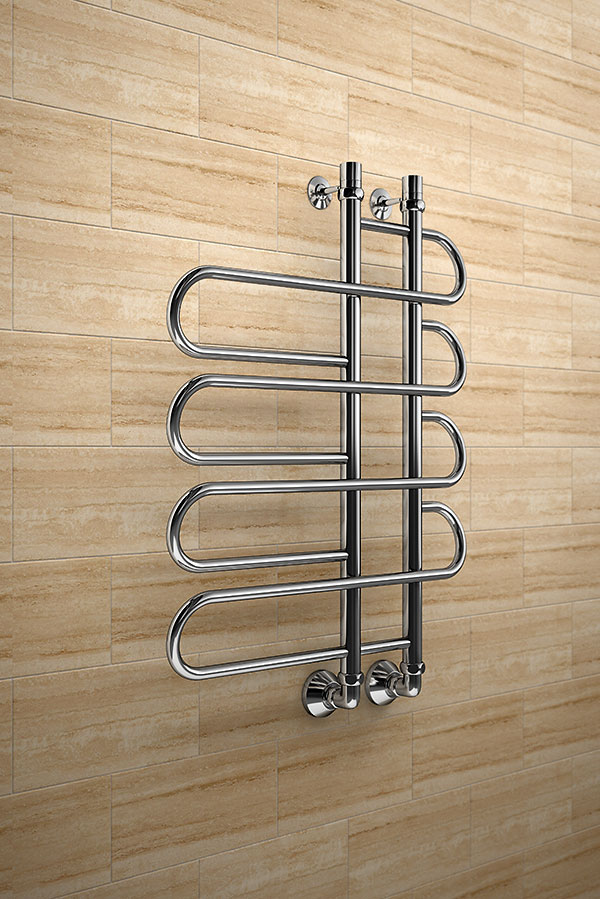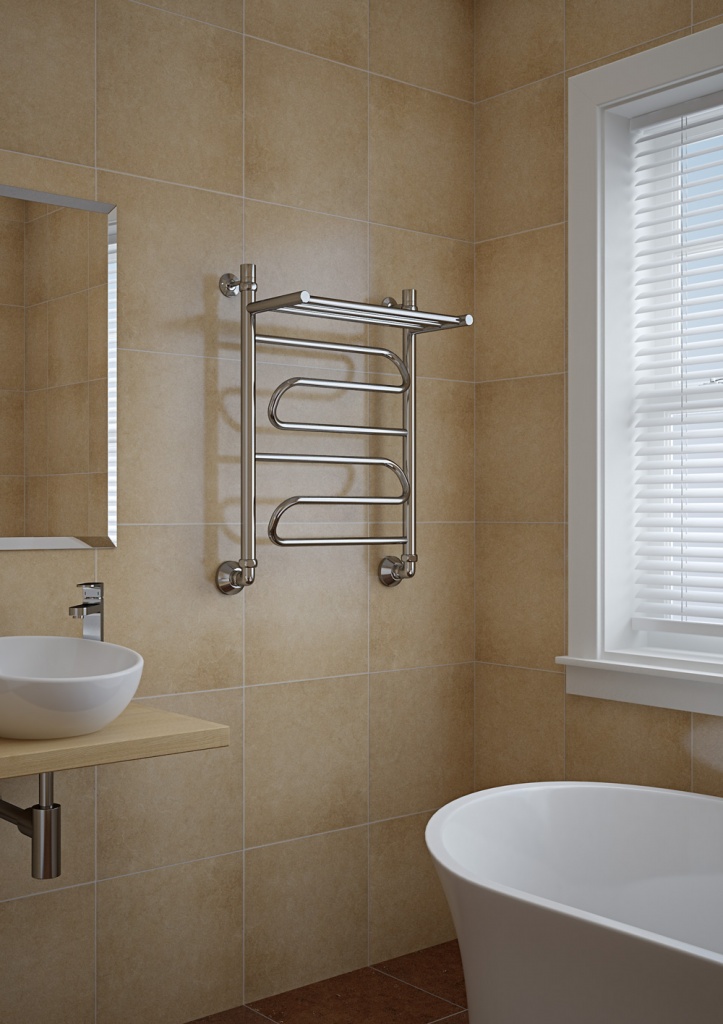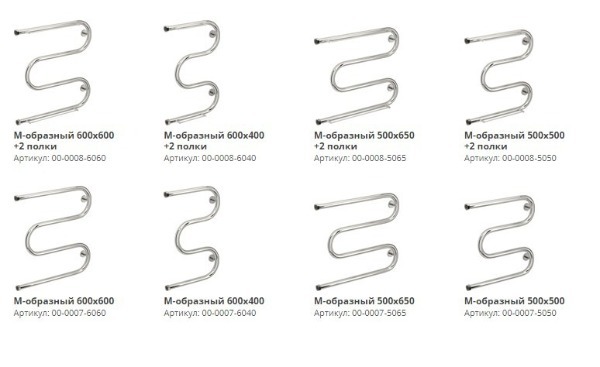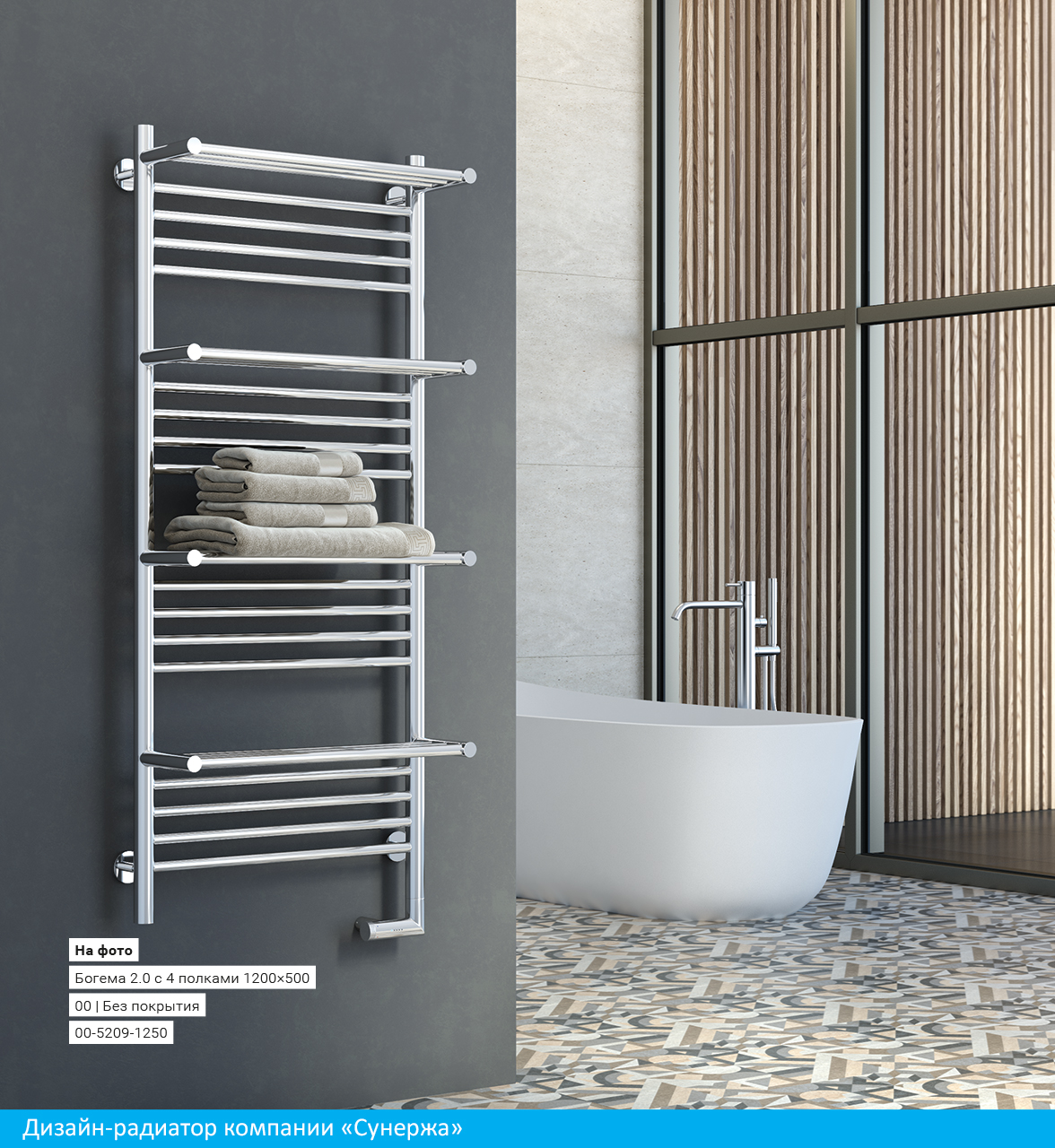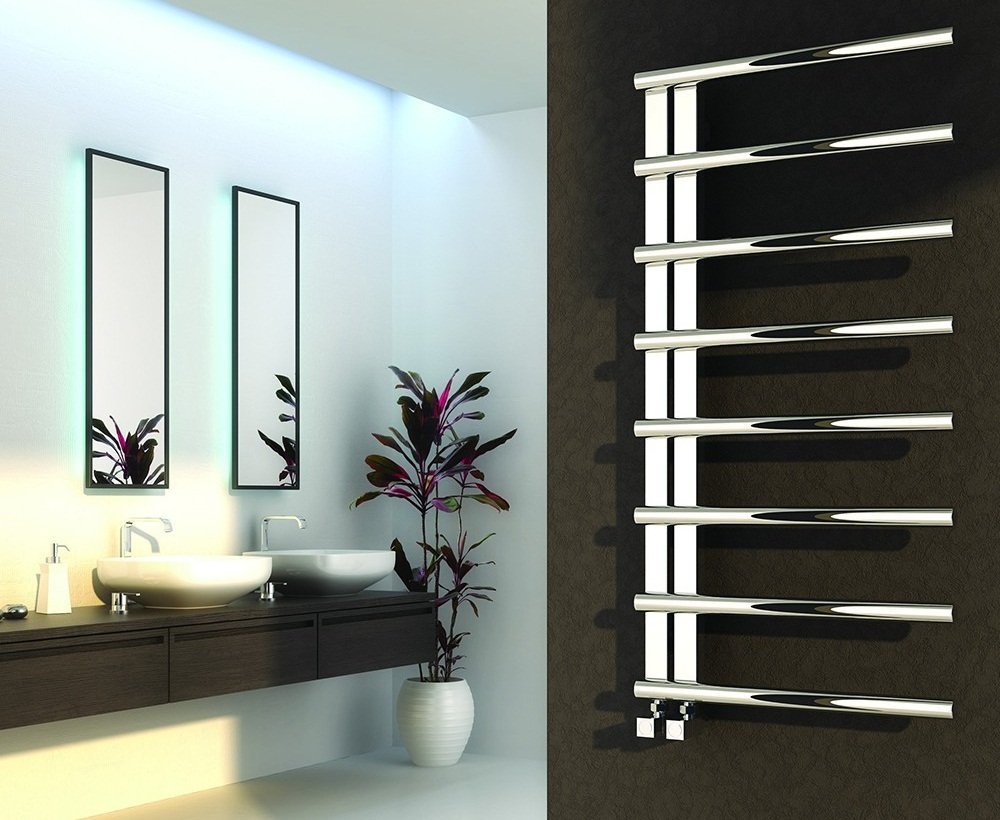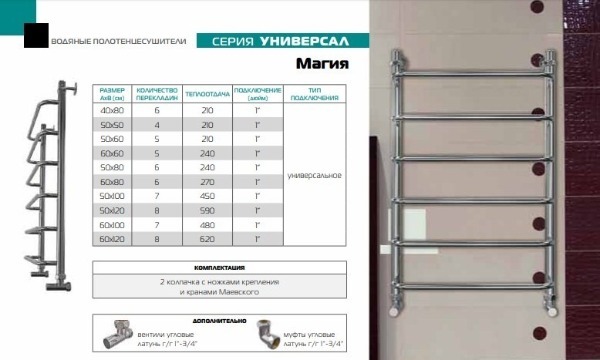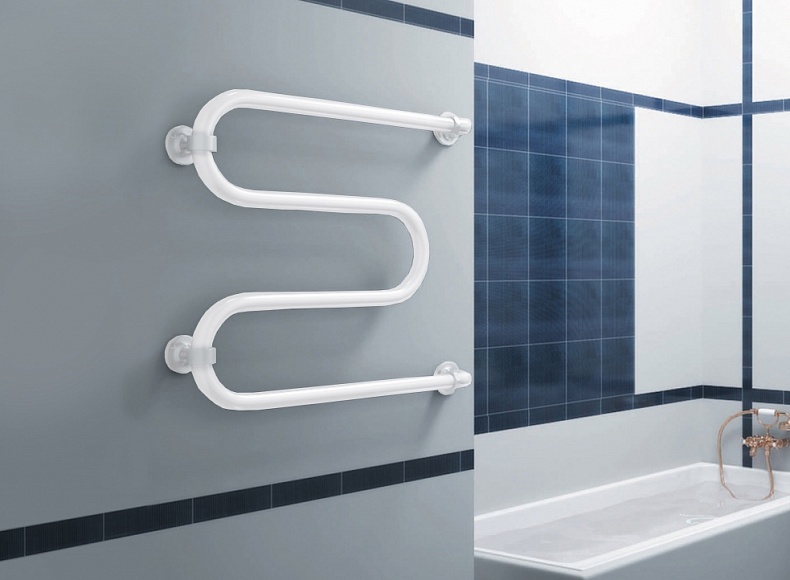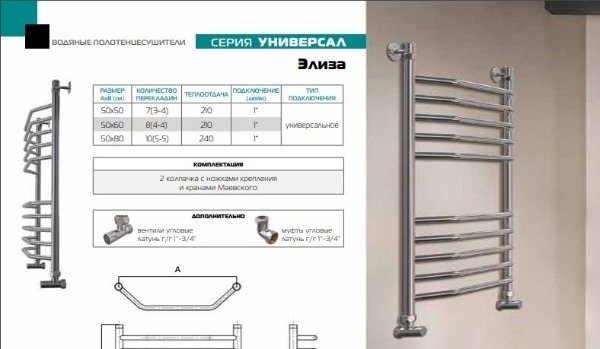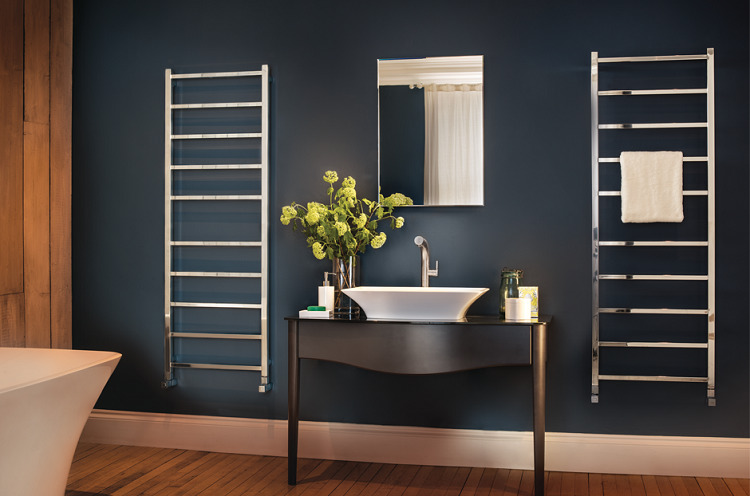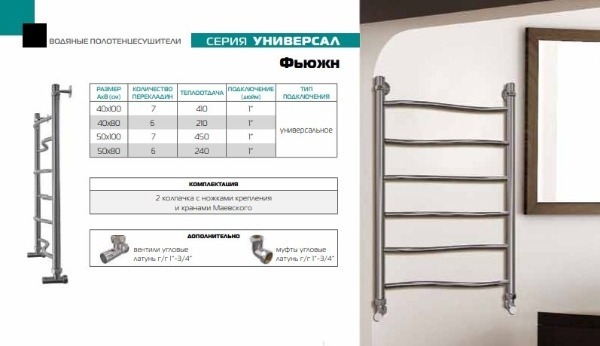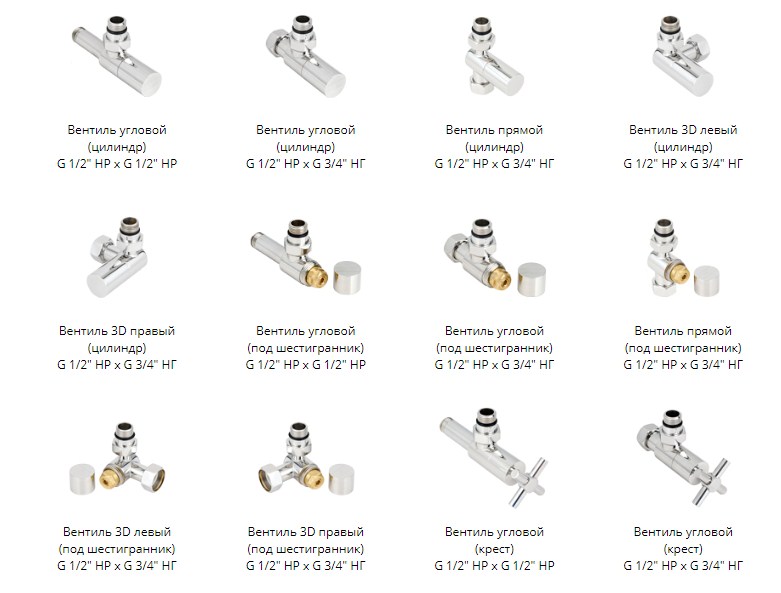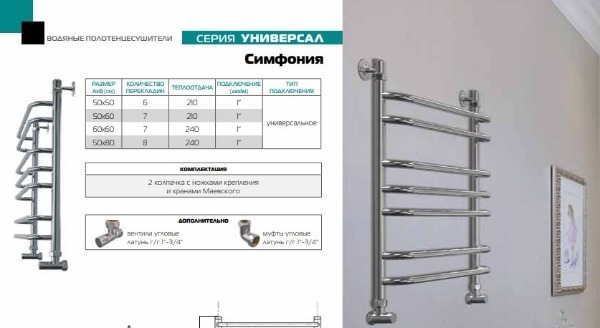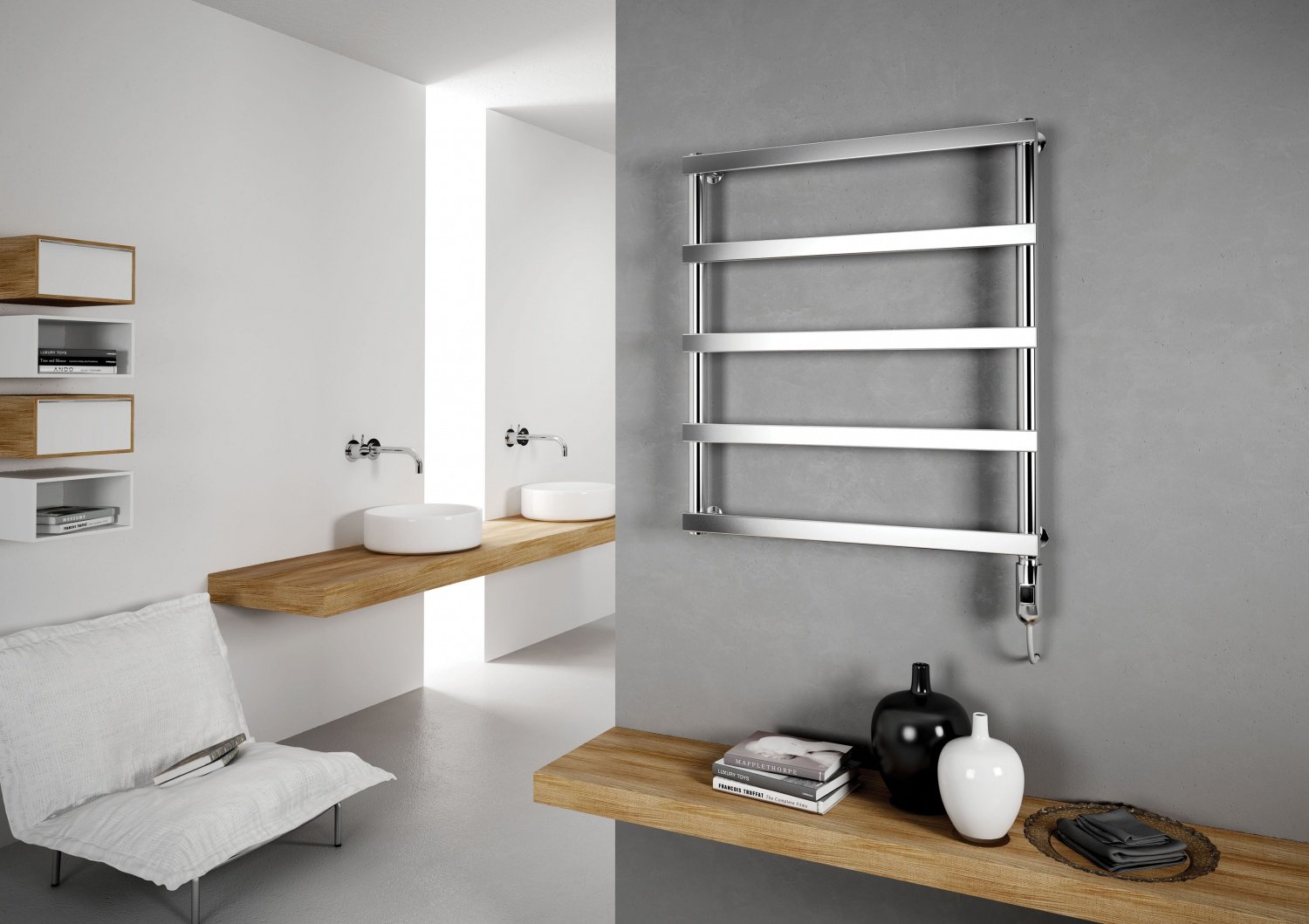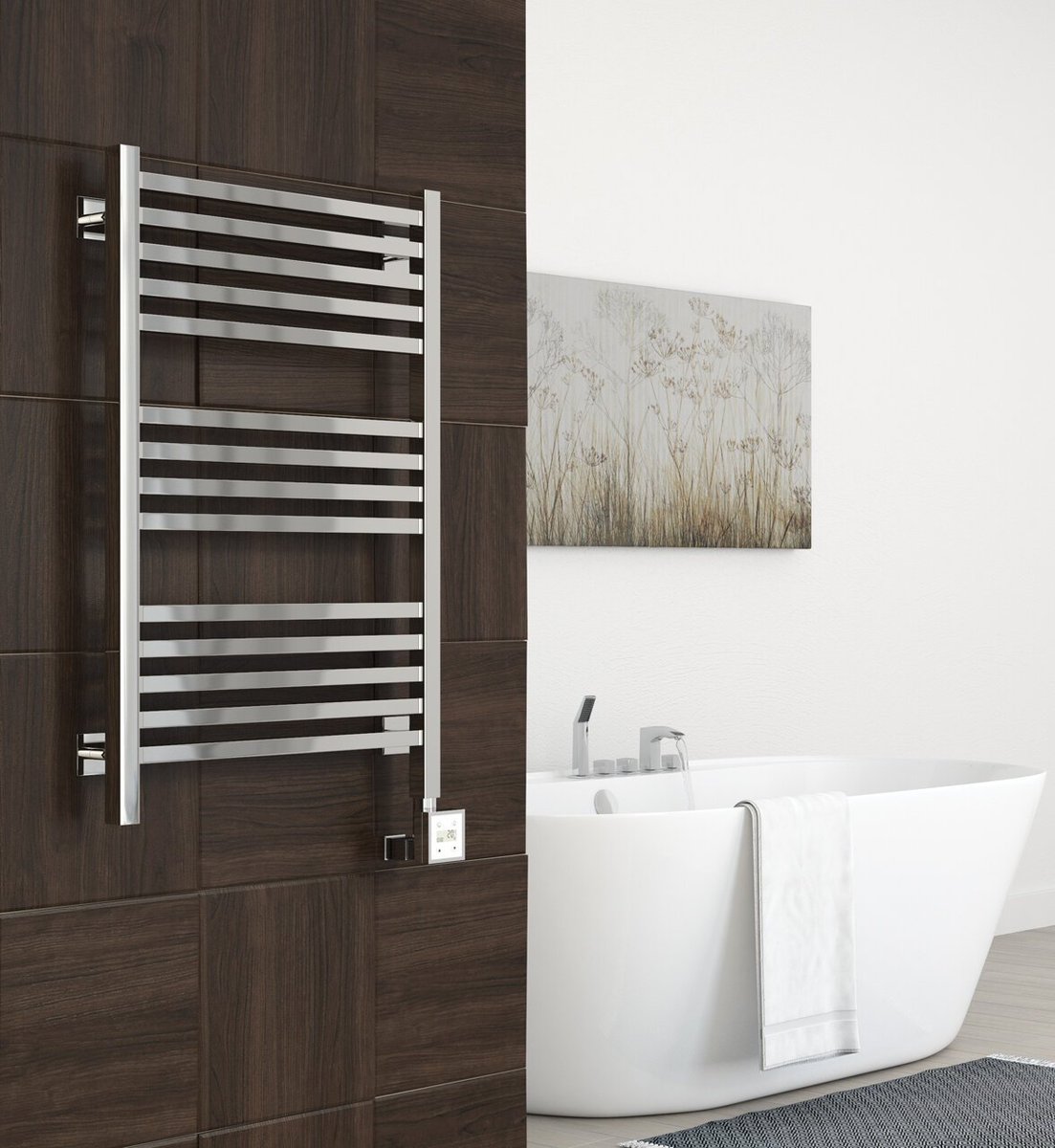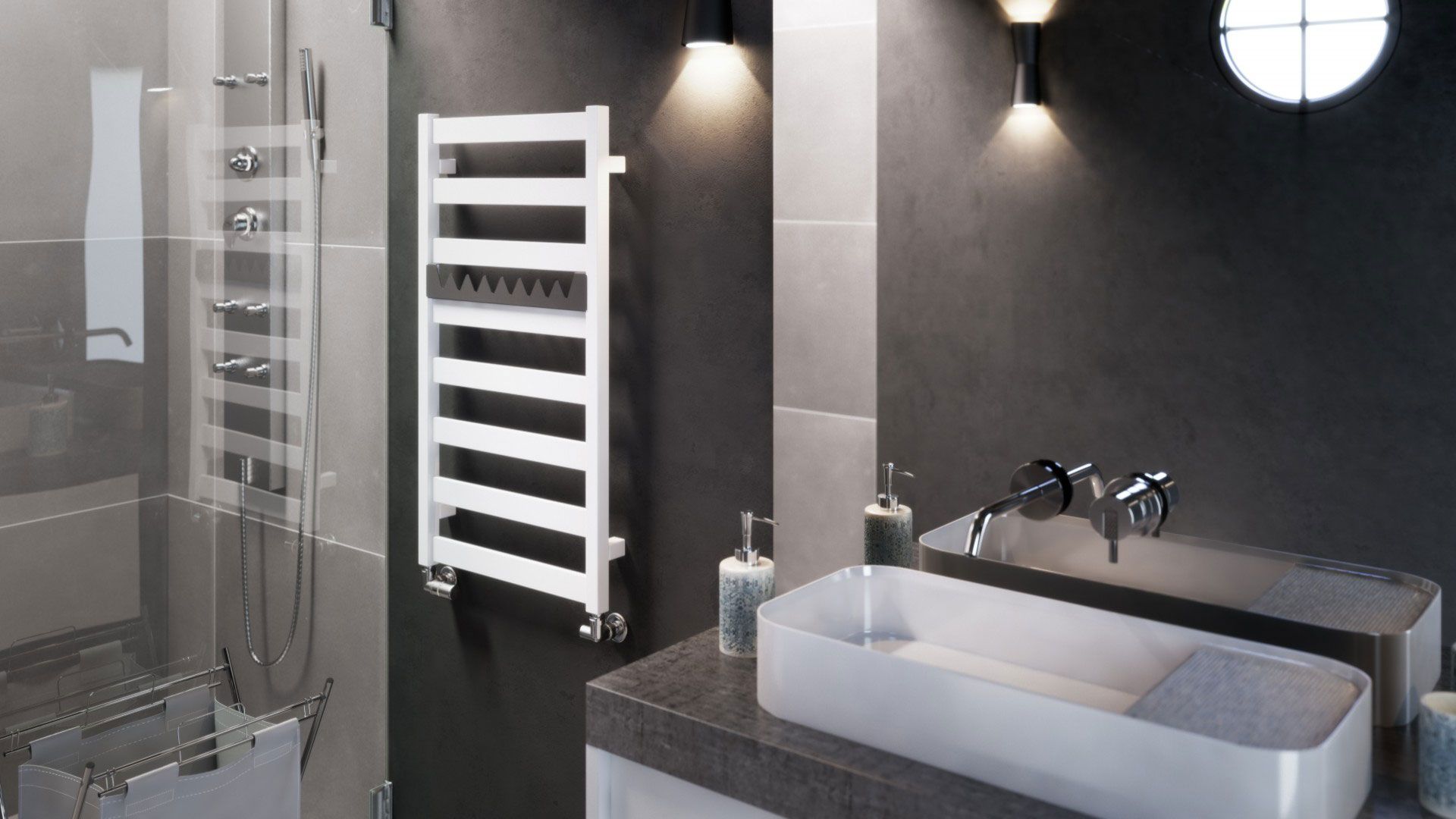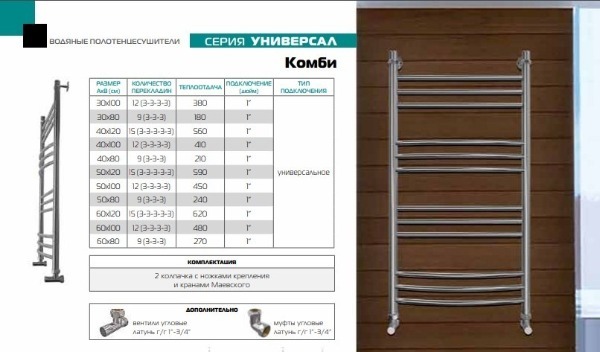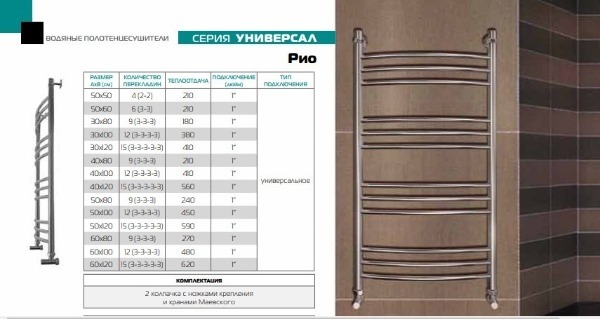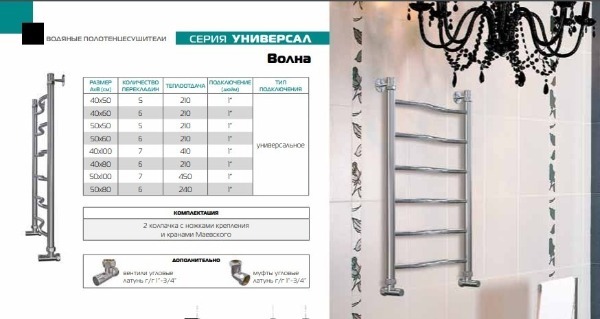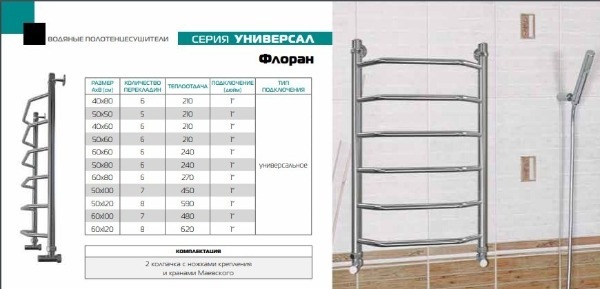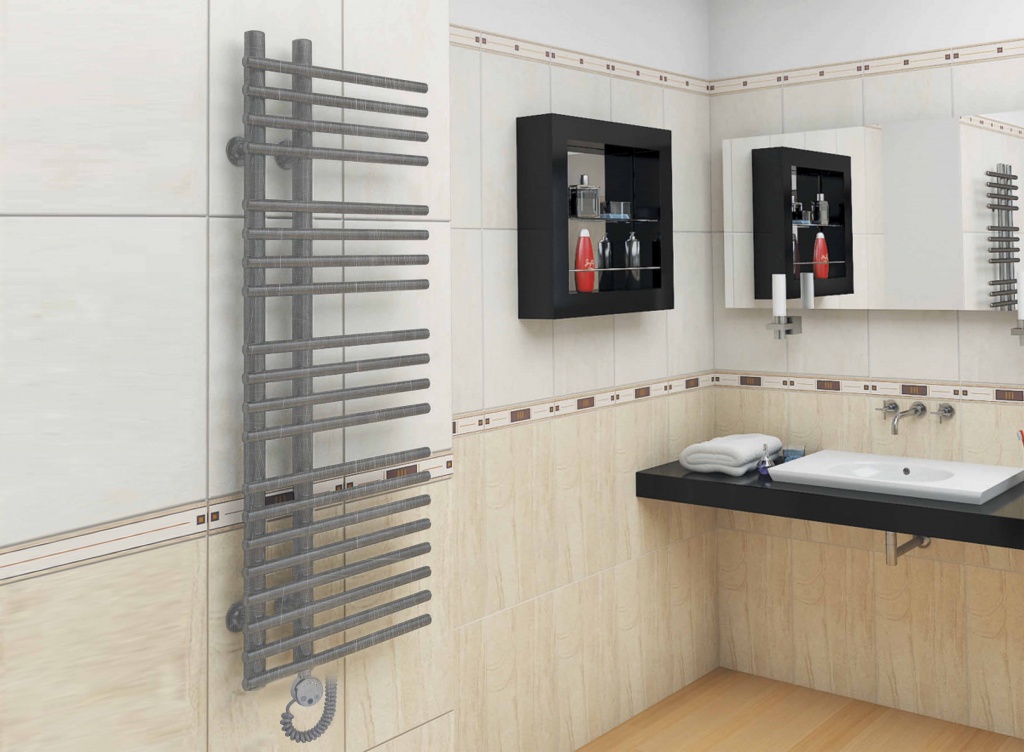Materials for the manufacture of heated towel rails
The material from which the device is made is critical in pricing. The strength of the structure and other important characteristics depend on metals and alloys.
Black steel
An alloy of iron and other elements. The cheapest option. Excellent heat conduction. The outside does not rust due to the treatment with pentaphthalic paints. But there is no anti-corrosion coating inside, so such devices quickly deteriorate. They do not tolerate pressure and temperature changes and are better suited for country houses. In apartments, steel water radiators quickly break down due to the peculiarities of centralized water supply. Also, the outer coating swells over time and falls off. Such models are usually produced with a large number of joints. This increases the risk of leakage. If the device is a one-piece pipe, its price rises disproportionately to the quality.
Stainless steel
More expensive but durable option
Resistant to water impurities and pressure drops, which is important when installing a heated towel rail in an apartment building. Corrosion resistant
The paint coating quickly loses its appearance. The outer layer of chrome is optimal. There are also polished products. The wall thickness must be at least 2.5 mm. Such structures serve as long as possible. Self-installation is fraught with some difficulties due to the complexity of sealing threaded connections. Therefore, it is preferable to contact professionals.

Stainless steel towel warmer
Brass and copper
They are distinguished by the highest price. They have an attractive color. Due to the plasticity of such metals, various shapes are given to finished products. Brass and copper towel rails add luxury to the interior. They have maximum heat dissipation and do not corrode. The inner surface of water radiators made of these materials is galvanized. Otherwise, such devices quickly fail.
Heated towel rail functions
Most often, a heated towel rail is an element of the heating system. It is necessary for pressure compensation and is installed to prevent deformation of the pipeline. Recently, the "coil" is often connected to a hot water supply system or even an electrical model is installed. Such devices are no longer responsible for this function. But there are general tasks that can be successfully accomplished by heated towel rails of any type.
A modern warm pipe in the bathroom is necessary for:
- heating the room - it is much more pleasant to carry out water and care procedures in a warm room;
- preventing the appearance of mold formations in the bathroom - the humidity decreases, and due to this there is no breeding ground for the fungus;
- drying wet things - there is an excellent opportunity to dry the towel after taking a shower, washed underwear, socks;
- creating a comfortable microclimate due to the stability of the temperature in the room;
- adding a stylish and elegant accent to the bathroom interior.

What is this device?
This is a device that looks like a curved coil or grate. It is designed to dry towels, at the same time acts as a radiator that warms up the bathroom. If the heated towel rail is selected correctly, then condensation on the mirrors will not appear in the room and the fungus will multiply. When the appliance is turned on, you don't have to worry about the temperature in the bathroom.
 Some wall mounted models of electric towel warmers can be almost up to the ceiling. They are designed to dry multiple rows of items and are appropriate in large bathrooms.
Some wall mounted models of electric towel warmers can be almost up to the ceiling. They are designed to dry multiple rows of items and are appropriate in large bathrooms.
Electric heated towel rails differ significantly in appearance, power and other parameters, but they have common features. They all require an electrical connection. When arranging a bathroom with a device of this type, you have to carefully monitor compliance with fire safety rules.
On the other hand, with an electric heated towel rail in the bathroom it is always comfortable regardless of the presence of hot water in the pipes, as happens if a water appliance is installed.
Installation steps
If the task is to replace the old device, then first you need to remove it, which is very simple. The first step is to turn off the water and unscrew all the fastening nuts by means of which the device is connected to the water pipes
Then you should carefully remove the fasteners and the device from the wall.
Upon completion of the dismantling work, you can take a new device out of the box and begin installation. Holders are attached to the new model and connections are screwed through which water will be supplied. Further, the structure is attached to the wall, and the necessary marks are made with a pencil.
The next step is to drill all the holes in the tiles and insert dowels into them. It is better to use plastic products as fasteners. After making sure that the device is located correctly, it remains to fix it on the wall and connect it to a common piping system or central heating.
It is important to note that many bathroom coil manufacturers and their distributors or retail outlets offer a range of installation services. In this case, the task is performed by a specialist, and the consumer is provided with a full-fledged guarantee for installation work.
When buying a new device, it is better to take advantage of this opportunity, since this will avoid many troubles in the future. But if independent installation does not seem like something incredibly difficult, then it is quite possible to realize it with your own efforts.
Material selection tips
The main material for the manufacture of heated towel rails is black or stainless steel. Less commonly, they are made from brass, copper or aluminum. Steel appliances are perfectly combined with the material of heating and hot water supply systems, the pipes of which are made of the same material.
The outer surface of such heated towel rails is chrome plated or painted, and stainless steel appliances are only polished.
On heating and hot water supply systems, water heated towel rails are installed, which cannot be used as grounding. Pitting corrosion of the metal of the pipes will quickly disable them. Moreover, the rules for the operation of heat and water supply networks prohibit the use of pipes instead of a grounding or neutral wire.
Towel dryers made of non-ferrous metals are even more susceptible to electrochemical corrosion due to the presence of stray currents and the resulting galvanic couples. This is especially noticeable when connecting copper and brass devices to metal-plastic pipes.
In this case, heated towel rails must be grounded, which is difficult to implement in Soviet-built houses. Aluminum heated towel rails fail very quickly in apartments with central heating, where the coolant is chemically treated to reduce rigidity.
Specifications
When choosing a heated towel rail, check its technical characteristics.
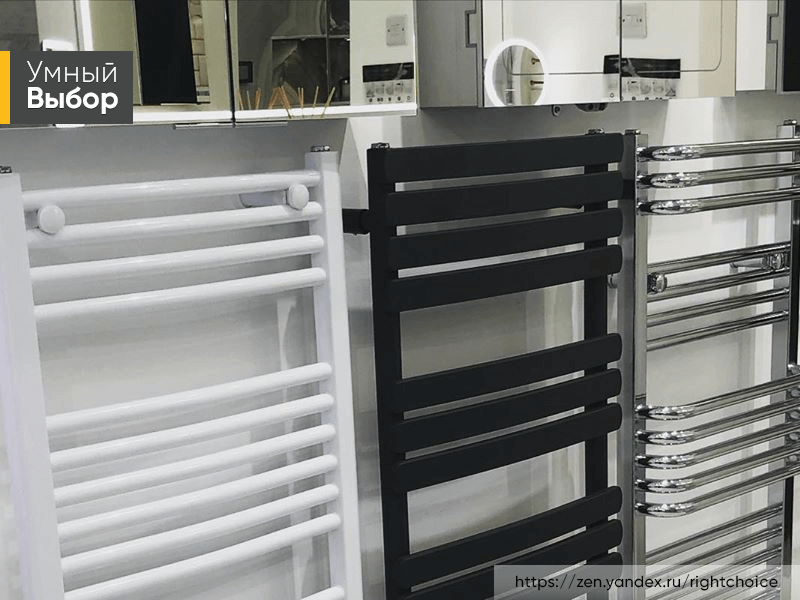
We will tell you what to look for when buying a water device:
- Heating capacity of heated towel rail... The bigger, the better. This parameter depends directly on the surface area of the device and the temperature indicators of the coolant.
- Center-to-center distance between terminals for connection to hot water supply... The standard value is 50 cm, but there are other options. It can be ignored if you are planning a new piping.
- Tube wall thickness... It must be at least 2 mm - the operating period and heat transfer of the device depend on it. The unit, made of a pipe with a cross section of one or 3/4 inch, will completely cope with heating a small bathroom.
- Maximum operating pressure, coolant temperature... The higher the values, the more difficult conditions a heated towel rail can work.
- The presence of a "Mayevsky crane" with a relief valve... Due to it, you can easily carry out the first start-up of water in a newly installed device, as well as when connecting hot water after summer maintenance. The valve allows you to expel air locks for normal circulation of the heat transfer fluid.
Dryers that run on water may have a different connection diagram to the hot water supply. The most practical is lateral, since products with this design can be adapted to any installation location. This allows the connection unit to be made almost invisible so that it does not spoil the interior.
Indicators that need to be taken into account when selecting an electrical appliance:
- Power... The device in 100-150 W easily copes with heating one square of the bathroom. This is enough for drying towels. But to warm up the room, you need a more powerful unit.
- Method of connecting the device to the mains - open or hidden... The first option is simpler - wires from the device to the electrical outlet are laid along the surface of the wall. In the second case, they are disguised as trim, which increases safety.
- Profitability... Electricity consumption can vary significantly depending on the type of appliance. Dryers are equipped with heating elements with a capacity of 100-2000 watts. In powerful models, sensors are often installed that turn them off automatically when the desired temperature indicators are reached. This helps to save electricity.
Also consider the availability of additional functions. Devices are equipped with timers, thermostats, indication. This makes the unit a little more expensive, but more comfortable to use.
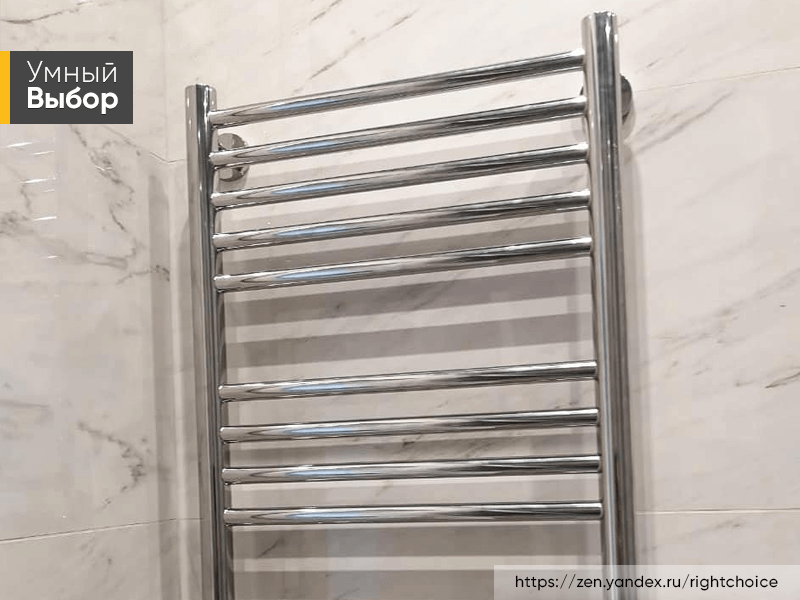
Electric heated towel rail TERMINUS Victoria P7 450 × 750 electro with thermostat
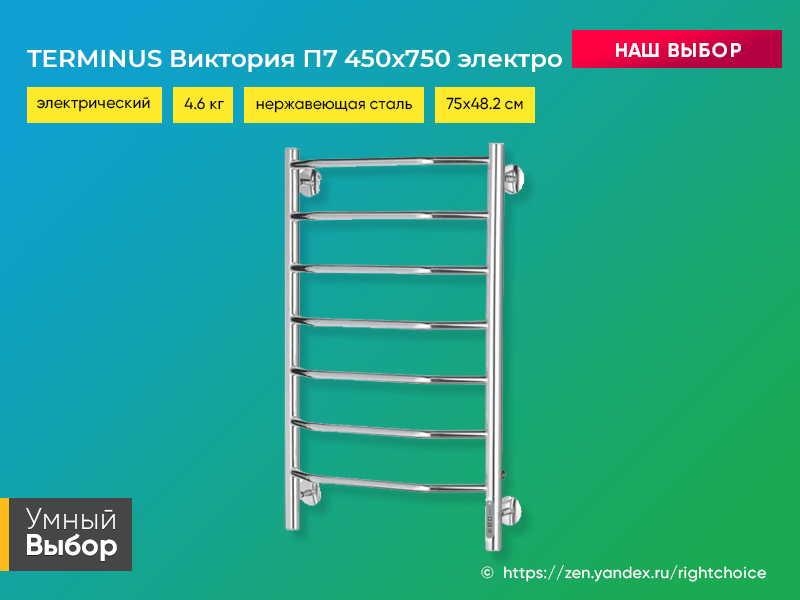
- fast heating;
- full set;
- with thermostat.
A modern electrical appliance in the form of a ladder with seven crossbars is made of high-quality stainless steel. Dimensions - 75x48.2 cm, center-to-center distance - 45 cm
The power of the appliance is 103 W. Heats up to a maximum of 65 degrees - it is impossible to burn yourself against the walls. Conveniently, the device can be turned off at any time by pressing a key. Equipped with a thermostat that prevents the heated towel rail from overheating, as well as an LED indicator. Manufacturer's warranty - 2 years. Includes four telescope mounts, cable-plug connection, hidden connection module, instructions. It costs from 6,000 rubles.
Can be advised for those looking for a quality electric heated towel rail.
Owners note that the appliance quickly heats up to the desired temperature. This indicator can be adjusted smoothly. The kit contains everything you need for installation.

Pros:
- material - durable stainless steel;
- switching on and off at any time;
- smooth temperature control;
- led indicator.
Material
The material for the manufacture of heated towel rails can be various types of metals or their alloys. And depending on which one was chosen for production, the service life and resistance of the product to wear may differ.
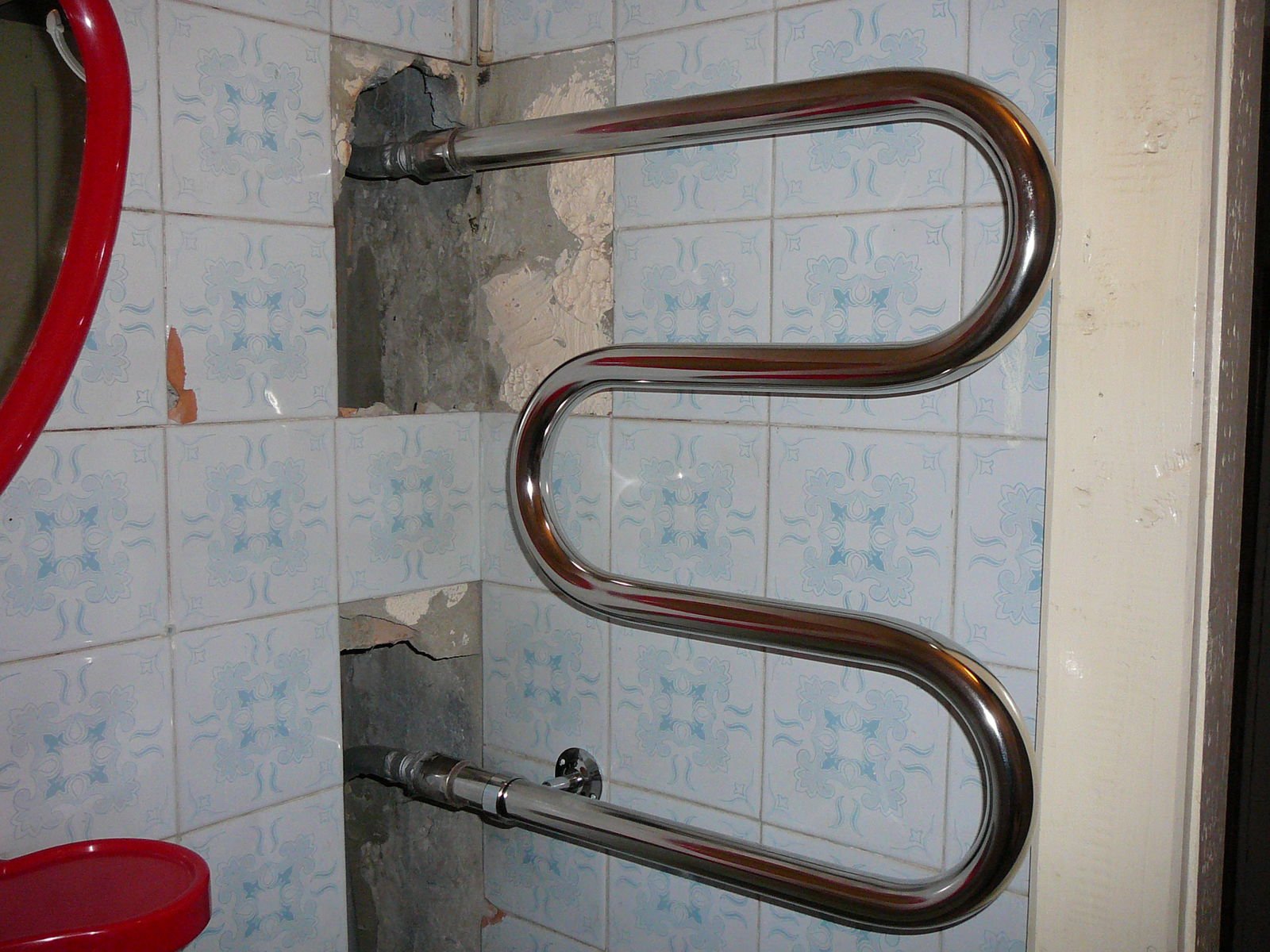
Heated towel rails are made from:
- black steel is the most budgetary option, and this is where its advantages end.The fact is that products made of black steel do not have an internal anti-corrosion coating, are not sufficiently resistant to the effects of an aqueous medium and a heat carrier. It is better to choose such systems for private houses with autonomous heating, where there is no high pressure and drops;
- stainless steel is the most demanded and popular type of coil. It is both a budget and at the same time reliable material that will last a long time. It is because of its affordable price and durability that it is recommended to be installed in apartment buildings. Such a heated towel rail is a product without welded seams, and therefore has the ability to withstand the high pressure that is so common in central water supply systems. Products can be painted, chrome-plated or coated with materials that look like bronze or brass;

At the time of purchase, carefully inspect the joints for defects. Overly budgetary cost may be due to poor product quality;
- copper is one of the most reliable options, but far from the cheapest. Despite the light weight, copper products have high thermal conductivity and corrosion resistance. They are perfect for connection to both a central and an autonomous hot water supply system, since they can withstand high water pressure well. Copper heated towel rails are a great accessory that can decorate any interior, especially when combined with copper fittings;
- brass - has characteristics similar to copper - has excellent heat transfer and resistance to aggressive water. However, it should be borne in mind that imported brass products on the market today are not able to withstand high water pressure in apartment buildings. Therefore, it is better to use them in autonomous heating systems.
How to choose a heated towel rail
A private bath in the yard is a great way to relax and unwind after a week of work, but a shower or bathing is more suitable for daily hygiene of the human body. If the apartment or house does not have a bathroom, then you are unfamiliar with such a heating device as a heated towel rail.
Simultaneously performing the function of drying things, this appliance must heat the air in the bathroom higher than its temperature in other living quarters.
The heated towel rails installed in apartments very often have an unpresentable appearance, and sometimes it is just a curved pipe of the hot water supply or heating system, so residents have a desire to replace it. All these heated towel rails are water, which ones are better to install and how, an ordinary person cannot immediately figure out. How to choose a heated towel rail in the bathroom and not be mistaken if the shops selling plumbing offer countless types and forms of them?
Most consumers first of all pay attention to the appearance and price, shape and size of heated towel rails, forgetting about their heating function, as well as about the pressure that this or that device can withstand.
Review of the most popular brands - models
Today on the market there is a large selection of water heated towel rails of various types. It is very difficult to immediately identify among the commercially available devices when they all suit you in terms of technical parameters.
The St. Petersburg company "Sunerzha" produces water heated towel rails from simple models to design developments. The products of this company are reliable, durable, made of stainless steel. The technical parameters of the devices fully comply with SNiP. Pipes are purchased abroad and during the production process at each technological stage are checked for integrity against high pressure. The devices are fully adapted to the central heating system and can withstand temperatures of 105˚C, are designed for pressures from 3 to 25 atm.They can be installed not only in the bathroom, but also in the corridor, kitchen and other small spaces.
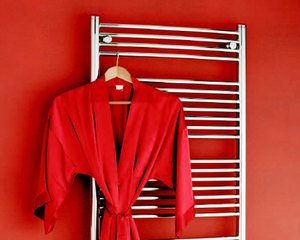
are polished in several steps
The simplest types of products are U-shaped heated towel rails, with a power of 0.5 kW and a price of 1800 rubles.
One of the most demanded devices is the Elegy water heated towel rail, which is a gracefully curved coil. All elements are located in different planes, and this makes it possible to dry household items more efficiently. The heat transfer of such devices is from 230 to 621 W, and the size range starts 60 * 40 cm and ends 120 * 60 cm. Prices, respectively, from 7500 r. up to 13 500 p.
The Galant series of these devices is also popular. Its traditional look, location of jumpers, practicality do not leave the buyer indifferent. The company produces 14 types of this model, differing in size. They can be selected for a room of any area, device sizes from 50 * 40 cm to 120 * 60 cm, corresponding to heat transfer from 183 W to 568 W. The price is also attractive - 6 800 rubles. for a smaller size and 13,700 rubles. - for a larger one.
The basis of the Bohemia series is the elegance and functionality of the jumpers. The device is available in 16 sizes and can be supplemented with a shelf. Made of food grade stainless steel, it can withstand pressure from 3 to 25 atm and coolant temperature up to 105˚С. The minimum size is 50 * 30 cm, and the maximum is 120 * 60 cm, the power, respectively, is from 197 to 834 watts. The price of this series starts at 8200 rubles. on a small size and ends at 17 900 p. the biggest one.
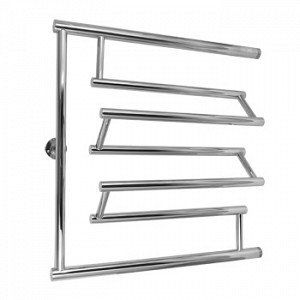
"Nika" plasma polishing
Budget coils "Nika" can be with bottom, top and side connections. The most inexpensive P 1 32/80 costs 1600 rubles, made in the form of the letter "P".
Coils of type M 1 60 * 40 and other sizes cost from 1650 rubles. They are made of stainless steel and are designed for small bathrooms, they have a classic M-shape. These devices are designed for an operating pressure of 3-25 atm, heat transfer 125 W, side connection, 5-year warranty.
The improved mixed model PM 1 60/40 already has a large heat transfer of 232 W, with a wall thickness of 2-3.5 mm and plasma polishing, costing 2 690 rubles.
In the middle price segment, there are options for ladders with arcuate jumpers of the LD type. The cost of these devices starts from 6,000 rubles, heat transfer is 260 W, the heated area is 3 square meters. m, test pressure 40 atm. A staircase-bend of the same heat transfer type L Z will cost the buyer a little cheaper, the price of which is from 4,960 rubles. and a ladder L90, worth 5,120 rubles. with the same technical parameters.
Towel dryers of new designs are more expensive, for example, Nika LB 1 60 / 50−7, presented in three running sizes, costing from 9,000 rubles, with a heat transfer of 400 watts.
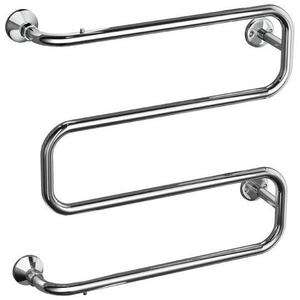
company AquaStal. Strength test
Water heated towel rails of the economy class Margroid, type 35 of the simplest type, cost from 800 rubles. (32 * 40 cm), with an increase in size, the cost increases (50 * 80 cm - 1250 rubles). Heated towel rails of the middle price category Margroid, type 24 cost from 1650 rubles. (32 * 40 cm) and above.
Heated towel rails of the so-called premium class cost more than 3500 rubles. and have an original look, such as Margroid 11 A, with an initial price of 7,340 rubles. (60 * 60 cm). There are devices on the market made not only by representatives of these companies, but also by many others. And basically, these are high-quality products suitable for our conditions of thermal systems. You just have to decide on the required heat dissipation for your premises and an acceptable appearance for you.
Features of choosing the size of a heated towel rail
If there is enough space in the bathroom to install a heated towel rail with a large heat exchange surface, then clothes can be dried on it more and the room will become even warmer, but the price of such a device will cool the ardor of the buyer.
When choosing the shape of a water heated towel rail for a bathroom, it is necessary to focus on the distance between the points of connection of pipes to the heating system. The standard distances between the centers of the connected pipes range from 300 to 700 mm, but there are only 7 of them, since an interval of 50 mm is observed between the dimensions.
Distortions or installation of the device with a stretch lead to additional loads on the material from which it is made.Improper installation leads to a violation of the integrity of the pipes and flooding of the living space with a coolant.
The closer the heater is to the floor, the better the air exchange in the bathroom, but it is inconvenient to dry towels and other things. The location of the heated towel rail under the ceiling is unprofitable in all respects, therefore the optimal place for its installation is from 1 to 1.5 m from the floor. It is better to equip a large bathroom with several small heated towel rails than to install one from floor to ceiling.
The choice of the device in appearance and place of installation
The traditional form of a heated towel rail is a coil. But users are already tired of such products and do not always fit well into the interior of the bathroom. The modern market offers customers various models with original designs. Ladder-shaped devices are very popular now. The convex elements of the devices are very convenient for hanging small items of clothing, and the original design will emphasize and complement the interior of the bathroom.
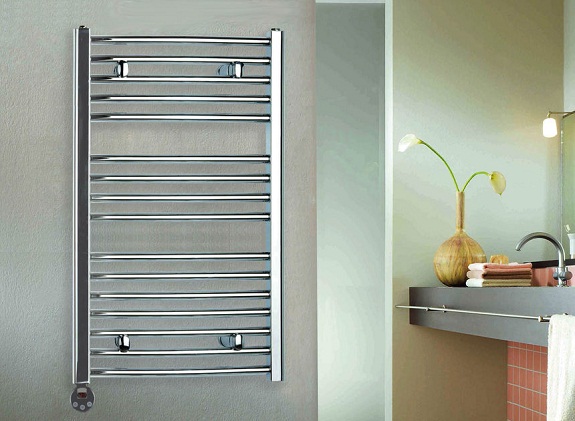
The convex shape of the towel warmer pipes allows you to conveniently hang towels
A few tips:
When buying a heated towel rail, pay attention to the number of horizontal elements, the higher it is, the higher the heat transfer
The convex shape of the tubes makes the device convenient for drying clothes.
For a small bathroom, it is better to buy a device with additional side elements. In this design, the main part is attached to the wall, and the other two open like cabinet doors.
Also, in a small bathroom, it makes sense to install a model with a shelf for placing towels or hygiene products. Such models significantly save free space in the bathroom, which is often not so much.
It is also very important to consider the mobility of the product. There are a number of appliances that are mounted on the wall, but there are also those that are simply placed on the floor.
Suspended models have one important advantage - compactness, but they cannot be carried from place to place. Floor standing units do not require drilling or mounting hardware; instead, they are equipped with stable feet.
Connection options
There are six connection methods that you need to familiarize yourself with before installing the dryer.
Lower
This connection method is rarely used due to the fact that it is not easy to install products using this method. The bottom connection is used only if Mayevsky taps are installed in the bathroom. Experts advise using such a connection if you need to connect the overall model.
Right
Sometimes people decide to install vertically elongated drying appliances in the bathroom. Such devices are recommended to be connected by the right side method. This method of connection is considered universal, since it is suitable for models in the form of ladders and for standard designs.
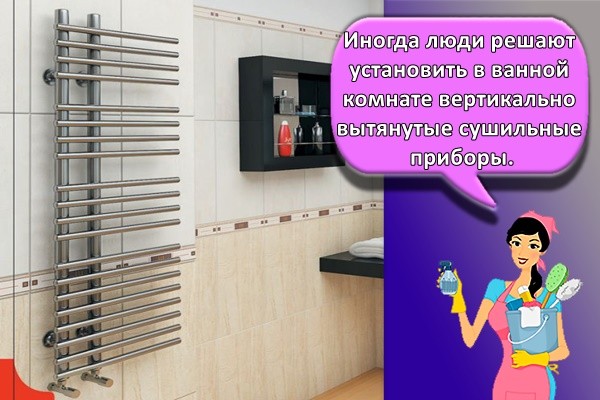
Left
The left connection is used infrequently, since additional reinforcing fittings are needed for its implementation. They are installed in at least two places to make the mount more secure. The main advantage of such an installation is that it saves space in the room.
Diagonal
To improve the circulation of water in the system, it is recommended to use a diagonal connection type. With this technique, liquid comes in from the top and flows downward.
Upper
Some people advise using the top type of heated towel rail connection. The main advantages of this option include the following:
- independence from the rate of circulation of the liquid in the riser;
- versatility;
- does not need regular air release.
Corner
The most non-standard installation method is considered to be the corner placement of the dryer. In this case, the structure must be placed at a distance of 2-4 centimeters from the riser.
Features of heated towel rails
Water is used as a heat carrier in a water heated towel rail, and its operation can depend on many reasons. The devices can be divided according to the type of connection to the system - top, bottom, side, according to the throughput rate of the coolant, power and material of manufacture.
Structurally, a water heated towel rail is similar to a radiator, consisting of pipes of different or identical diameters, welded into a multi-channel heat exchanger. A correctly installed water heated towel rail does not need to be constantly monitored in the future, the technical parameters of the device correspond to the characteristics of heating radiators. It becomes a full-fledged efficient heater that does not add economical costs to the central heating system.
 In appearance, water heated towel rails are:
In appearance, water heated towel rails are:
- Standard, having the form of a curved pipe, shaped like the letters "P" or "M" with a small heat transfer of about 0.5 kW.
- Upgraded, with shelves (improved ordinary heated towel rails).
- Elegant, representing devices of original forms such as ladders, foxtrot and others.
Water heated towel rails can be manufactured:
- Stainless steel. For domestic conditions, this is the best choice. The outer part of such devices can be chrome-plated, painted, polished.
- From non-ferrous metals. Such devices have a short service life due to their susceptibility to the influence of the aggressiveness of water at its high temperatures in the heating and hot water supply circuits and the presence of harmful impurities that destroy pipes.
Types of heated towel rails for the bathroom
What is a heated towel rail? It is a battery-like device with crossbars. Serves for drying towels, linen, heating the air in the bathroom, reducing humidity.
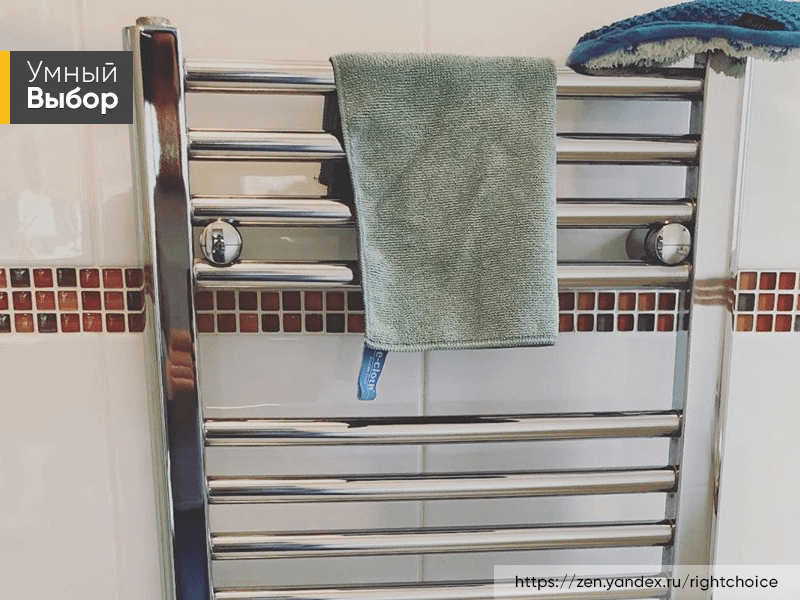
Apparatus are divided into two types: water and electric. The former are connected to the hot water supply and are heated by circulating hot water. The latter are heated by electricity. A water heated towel rail assumes a higher heat dissipation. Accordingly, with the same dimensions, it heats better than an electrical appliance, it is used as a heater. A significant disadvantage is cold pipes in the summer, when there is no heating or water is turned off for preventive maintenance. Also less resistant to water hammer.
What are the electric heated towel rails? They are divided into dry and combined. Inside the first one there is a special heating cable. The efficiency of the device is less than that of water or combined analogs, the heating time can take 5-10 minutes. But the devices are economical - they consume electricity like an ordinary light bulb. They are easier to install and more compact.
Combined heated towel rails are filled with liquid, which is heated by the heating element inside the device immediately after energizing. Less energy efficient and more expensive. There are options that work both from hot water supply and from the network - they allow you to transfer the device to a more profitable mode at the right time.
All types of electric heated towel rails for bathroom have the following advantages:
- ease of use;
- reliable protection against leaks;
- the absence of air locks that impede the normal movement of the heat transfer fluid;
- zero risk of corrosion;
- switching on if necessary.
Installation of this device is possible anywhere.
Let's figure out which heated towel rail is better to choose: water or electric? If heating the bathroom is important, then it is better to prefer the first option. When the device is needed mainly for drying laundry, an electrical appliance is more suitable. You also need to take into account the individual characteristics of the communication system. If grounding is impossible, the electric model will not work, and if the hot water pressure is weak, it makes no sense to install a water device.
Also towel dryers can be rotary or stationary. The first ones are equipped with a special mechanism that allows you to rotate the structural elements by 180 degrees. This makes it faster to dry things - they do not overlap. Electric rotary dryers are more reliable than water dryers.
Review of popular models
There are seven models that are popular with buyers.
"Sunerzha Elegy"
This is a Russian-made product, which is notable for its convenience and attractiveness. The design features of "Sunerzha Elegia" will not allow the drying towels to slip and fall on the floor. Made of high quality stainless steel.
"Galant M-3"
This is a practical product, which, in addition to pipes, is equipped with a special horizontal shelf. The dryer has a thermostat, with which you can regulate the temperature of the pipes heating. When the system heats up to the desired temperature, heating is turned off.
"Fashion M"
A product with an unusual design with curved and straight lines. By installing such a drying product, it will be possible to dry small and large towels. The maximum heating temperature is seventy degrees.
Terminus Europe
This company has been engaged in the production of drying structures for a long time.
People who decide to buy heating equipment of this brand need to pay attention to structures without welding seams. They are of the highest quality, as they do not leak even after prolonged use.
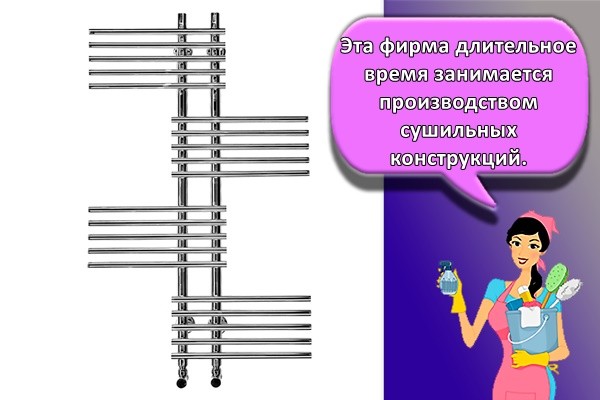
Energy U-G3
It is made in the form of a ladder and consists of nine metal rungs. The steel surface of the heating pipes is electroplasma polished. Despite the presence of welded seams, the product is of high quality.
Terminus Niagara
This is a water towel dryer made in Italy. The dryer is made of high quality Italian steel, which does not rust in damp rooms. Therefore, it is able to serve for more than a dozen years.
Tiffany World TW800GVS Bronze
A water-type dryer, which is capable of heating water to a temperature of 90-100 degrees. When creating it, a brass mixture with zinc is used.
Manufacturing material
The principle of operation of the above types of coils is practically the same. The only differences are in the heating method or the material of manufacture.
Modern manufacturers use the following materials:
- Stainless steel. It is considered the most practical, but it is afraid of interaction with aggressive impurities in the water. Stainless steel coils are often coated with chrome, polishes or waterproof paint. The most durable and reliable are chrome-plated models. Painted products are also in great demand, but their service life is much lower than that of the previous ones, and the paint wears off quickly.
- Black steel with protective coating. The inner walls of this material are treated with an anti-corrosion compound. Outside, the device is not much different from stainless steel models.
- Non-ferrous metals. In most cases, brass and copper are used here, which have good heat transfer, but a short service life. Such devices are famous for their aesthetic appeal, but not practicality.
When buying a stainless steel coil, you need to make sure that it is really high quality material. The thing is, there have been a lot of imitations on the market lately that look exactly like good stainless steel but are actually a common marketing gimmick. To avoid a rash choice, you need to ask the store for documents and a guarantee.

